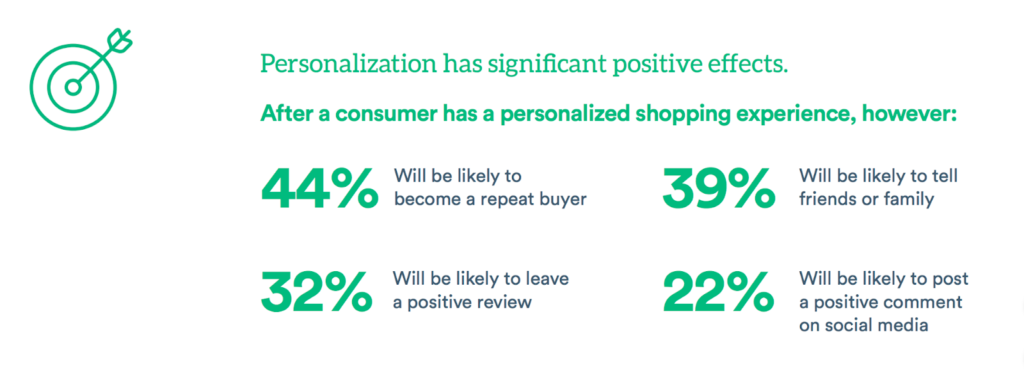
Table of Contents
- What is Dynamic Content?
- 7 Benefits of Dynamic Content For Your Business
- How Does Dynamic Content Work?
- Dynamic Content vs. Static Content
Personalized user experience has become a norm in recent years—it is not an option anymore. It has proven to engage users more efficiently, mainly because it makes them feel unique and heard by the brand.
This is where dynamic content personalization features come into play. Dynamic content is an important asset to any business that wants to influence a buyer’s journey. It helps boost awareness, convert viewers into buyers, and generate sales.

So, let’s first begin with understanding what dynamic content is all about.
What is Dynamic Content?
Dynamic content creates a personalized experience based on data, user interests, preferences, and behavior at that particular time.
In other words, the next time you log into your YouTube account and wonder why the video recommendations are so tailored to your preferences, you can rest assured that they are dynamically generated recommendations based on your past behavior and preferences on YouTube and other Google-owned websites and apps.

The company’s ultimate goal is to offer you content that you are most likely to engage with. This is also why today’s marketers must tap into dynamic content. With customer-centric marketing taking the central spot in the marketing industry, most brands seek to create excellent customer experiences at each point of the buyer’s journey.
Another popular example of dynamic content is Amazon’s recommendation engine. From personalization fields in emails to deals or offers, entire graphics on Amazon’s web page change depending on user data, behavior, and preferences.

Today, almost every e-commerce brand uses a dynamic content marketing strategy to engage with its customers effectively. For instance, you may visit an e-commerce site for the first time, add a few items to your favorites list, or possibly buy something. When you return to the site a few weeks later, the home page will have been altered to say “Welcome back!” and offer suggestions based on your previous activity on the site. This is how dynamic content can thrill the viewers.
Now that we have a basic understanding of dynamic content, let’s dive into its benefits.
7 Benefits of Dynamic Content for Your Business

1. Versatility
Dynamic content integration is the most versatile method for personalizing content, optimizing the customer journey, and increasing content effectiveness. This is especially significant for marketers looking to enhance their website presence and email marketers looking to improve their position in the highly competitive digital industry.
Dynamically generated content is useful for your business website, email marketing, and other deliverables like newsletters, campaigns, portfolios, and discussion boards.
2. Effective navigation
The success of content relies heavily on navigation because the website’s navigation allows users to flow from one page to another or from one category to another with ease. Hence, it’s vital to ensure that your website navigation is as engaging and accessible as possible.
An uninspired or frustrating navigation experience might lead to site abandonment and high bounce rates. Dynamic content integration ensures your website is presented to your viewers with the options and information they want while excluding unrelated or irrelevant content.
Most successful businesses make the most of their dropdown menus by including dynamic information such as product recommendations, special offers, and more to help website visitors discover the best of what they have to offer. For example, with WordPress dynamic content integration, brands can select the relevant information from the database and present it to the viewers based on their web page.
3. Personalized experience
Personalization is what businesses and marketers aim for. Personalized user experiences are unique and special, based on previous engagement and contact preferences. Dynamic content helps businesses execute personalized strategies.
Personalization is undoubtedly one of the most thrilling and powerful (and, dare we say, entertaining) solutions available to enhance your business engagement. Marketers can use SEO dynamic content to create a personalized experience for users by using relevant keywords.

SEO dynamic content allows you to engage with your target audience on a personal level at any time without frustration. For instance, if you are out of the office or unavailable, personalization allows you to send a warm message to anyone who visits your website.
4. Relevance
Are you tired of being ignored? It’s possible that static, irrelevant content is to blame. Relevance directly impacts engagement levels regardless of which platform you use dynamic content on. The more relevant the information, the higher the level of interaction for brands.
This includes increased open and click-through rates on email newsletters, more time spent on a website, and more CTA button clicks, among other things. It will be more difficult to resist because the content is personalized to the user as per their preference. For example, relevant dynamic content can be displayed based on a user’s browsing behavior to provide the quickest path to a call-to-action.
5. Memorable
You’re not receiving the leads you expected? You may believe it’s because your prospects and clients are beginning to reject you. However, this is unlikely to be the case. The genuine cause could be as simple as the fact that they have forgotten who you are. In other words, when it comes to purchasing time, you’re not at the top of their list.
With dynamic content, businesses can continually engage with users, which helps promote brand awareness and message recall. It has a strategic impact at the perfect time (that “Oh yeah, I remember them” moment), causing them to turn to YOU in their hour of need. Dynamic content makes your brand one that your prospects and consumers will remember.
6. Specificity
Showing the same content over and over will not get you very far. Repeat leads. Repeat results. Repeat brush-off.
Redundancy is a pain! Customers build up repetition blindness, where the content they have seen repeatedly fades into the background to the point where they are no longer aware of its existence.
On the other hand, dynamic content can be tailored to the time of day, where the user is located, what sites were visited previously, and even real-time weather conditions to give the most relevant messaging. Brands that employ intelligent messaging to serve customized content to every consumer might help to avoid lead repetition.
7. Conversions
You can be missing out on the nurturing and navigation process if you’re getting clicks but no conversions. Brands may use dynamic content to attract and grab genuine leads—people interested in your product or service—and carefully move them to the next step. These people are already interested in buying your product or service; all they need is a little nurturing and direction.
There is no need to squander time or money on ineffective leads that die before you even get an opportunity to engage with users. With dynamic content, you can make the most of your opportunities.
How Does Dynamic Content Work?
To create dynamic content, data is collected using scripts in the HTML of a webpage that is altered to make the page more relevant to the user. This information is saved in the site’s database, making it a database-driven website.
A website must keep user information in a database to employ dynamic content. This is due to the majority of the content on these websites being saved in its database. The content is then used to build customized user experiences.

Besides, the dynamic content boosts conversions by making the user experience (UX) more relevant and intuitive. Many of these tactics work by minimizing the amount of unwanted and unimportant information provided to viewers, thus reducing friction, and/or by offering viewers the logical next step in their discovery process or customer lifecycle.
While not all dynamic content tools and technologies necessitate complex data analytics, they almost always require a well-maintained, centralized customer database. The dynamic content solutions generally,
- Are essential parts, plugins, or extensions of Customer Relationship Management (CRM).
- Are linked to a CRM via an application programming interface (API).
- Build separate databases that may or may not be linked to a central CRM and collect user data on their own.
Some classic dynamic content examples are
- Emails and newsletters
- Landing pages
- Forms and purchases
- Articles
- Website ads
- Product pages
Next, let’s look at the difference between dynamic and static content.
Dynamic Content Vs. Static Content
The main difference between dynamic and static content is that dynamic sites, on the whole, use server-side languages to process requests and generate pages and their contents in real-time. On the other hand, static pages are rendered in real-time, cached, and provided to the user.

When the internet was established, all website pages delivered static content, i.e., the same content to every user. Over the years, websites have gradually integrated databases driven by languages such as Java, Python, ASP, and others. This allowed web pages to be dynamic and show the user relevant content based on demographics or preferences.
The Last Word
Dynamic content takes advantage of the valuable information offered by your viewers, leads, and customers, such as their interests, preferences, and previous behavior. Integrate dynamic content creation knowledge by providing customized content to your potential customers.
Dynamic content is one tool in your arsenal for developing more personalized marketing tailored to the users’ demands. It tells us that every potential consumer is different and should be recognized as an individual with distinct and evolving questions.
FAQs
Dynamic content helps to increase website traffic, convert prospects into customers, and sell more of your products and services.
SEO dynamic content offers marketers the opportunity to produce highly targeted content based on various criteria, including demographics and client personas.
Email dynamic content is any personalized part of a message that modifies depending on data or user behavior you have collected about your subscribers.
1. Dynamic content based on demographics.
2. Dynamic content based on email data.
3. Dynamic content based on interest or preferences.
Since dynamic content features are the core strength of YouTube, it is a dynamic content platform.
Dynamic content is different for every user, meaning this type of content cannot be presented to multiple users at a time like static content, and therefore it is difficult to cache.
Latest Blogs
Learn how to rank on AI search engines like ChatGPT, Perplexity, and Gemini by optimizing your content for authority, structure, and relevance. Stay ahead in AI-driven search with this strategic guide.
Explore the best healthcare SEO services for your medical practice. Improve online visibility and effectively reach more patients in need of your services.
Discover top social media agencies specializing in banking solutions, enhancing financial services and driving engagement.
Get your hands on the latest news!
Similar Posts

B2C Marketing
5 mins read
Top Choices for Best Content Marketing Services in B2B Industries

Artificial Intelligence
5 mins read
How A Lead Generation Specialist Can Use AI-Powered Content Funnels to Drive Conversions

Artificial Intelligence
4 mins read